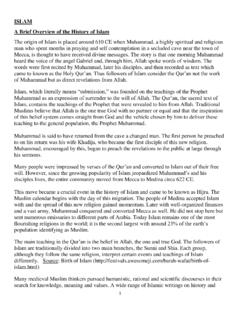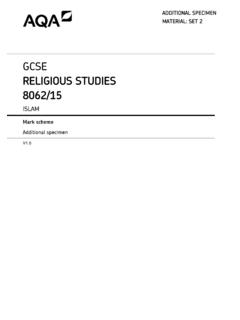Transcription of Unit Four - NCERT
1 Social and Political Life78 Unit Four2022-2379 Teacher s NoteEquality is a value and right that we have tried to understand in the Social and Political Lifeseries. Over the three years, we have deepened our conceptual understanding of equality. Wehave distinguished the idea of formal equality from that of substantive equality and the need tomove towards establishing the latter. Kanta s story, in the Class VII book, is an example of have also established that to understand equality it is important to delve into how inequalityis experienced and manifested. We have, thus, examined the connections between discriminationand inequality through the childhood experiences of Dr Ambedkar and Omprakash Valmiki inClass VI and VII books.
2 The impact of inequality on access to resources was looked at in thecontext of women s access to education. Rashsundari Devi and Rokeya Begum s writings pointto women s struggles to overcome this denial. We have often pointed to the Fundamental Rightsenshrined in our Constitution to highlight why equality and the idea of dignity that it containsis crucial to the functioning of democracy in unit looks more closely at the ways in which inequality affects different groups andcommunities by introducing the concept of marginalisation or exclusion from the Unit focuses on three groups, namely the Adivasis, the Muslims and the Dalits. These threegroups have been chosen because the causes that contribute to each group s marginalisationare different and they sometimes experience marginalisation in different ways.
3 In teaching thisunit, the aim should be to help students identify the factors that contribute to marginalisationas well as be able to recognise and empathise with the marginalised. You could help childrenidentify the marginalised communities in your region. In Chapter 7, we look at the experiencesof Adivasi and Muslim communities. Chapter 8 discusses ways in which the government as wellas these communities themselves have tried to address marginalisation through various government does this through its law-making function and through different policies andschemes that specifically target these communities as have used a variety of pedagogic tools in this unit data, poems, a storyboard and a case-study. Use the storyboard to discuss processes of marginalisation experienced by the case study on Dalits should lead to a discussion on the importance of the SC/ST Act as wellas the ways in which this law reflects the Constitution s commitment to Fundamental Rights.
4 Tounderstand the situation of the Muslim community, we have used data from different sources,which can be analysed in the class. Songs and poems have been used in this unit to break downthe boundaries created between social science and language textbooks and to establish that, inthe everyday lives of communities, this separation does not exist. Moreover, struggles for justicehave produced memorable poetry and songs that often do not find a place in chapter does contain several issues that may lead to contentious discussions within theclassroom space. Children are aware of such issues and we have to find a mature way of discussingthese. You play a crucial role in facilitating these discussions in order to ensure that no child orgroup of children feel discriminated against, ridiculed or left out from these Marginalisation2022-23 Social and Political Life80 Chapter 7 UnderstandingMarginalisationWhat Does it Mean to be Socially Marginalised?
5 To be marginalised is to be forced to occupy the sides or fringes and thus not be at thecentre of things. This is something that some of you have probably experienced in theclassroom or playground. If you are not like most people in your class, that is, if yourtaste in music or films is different, if your accent marks you out from others, if you areless chatty than others in your class, if you don t play the same sport that many ofyour classmates like, if you dress differently, the chances are that you will not beconsidered to be in by your peers. So, often, you end up feeling that you are not withit as if what you say, feel and think and how you act are not quite right or acceptableto in the classroom, in the social environment too, groups of people or communitiesmay have the experience of being excluded.
6 Their marginalisation can be because theyspeak a different language, follow different customs or belong to a different religiousgroup from the majority community. They may also feel marginalised because they arepoor, considered to be of low social status and viewed as being less human thanothers. Sometimes, marginalised groups are viewed with hostility and fear. This senseof difference and exclusion leads to communities not having access to resources andopportunities and in their inability to assert their rights. They experience a sense ofdisadvantage and powerlessness vis-a-vis more powerful and dominant sections ofsociety who own land, are wealthy, better educated and politically powerful. Thus, marginalisation is seldom experienced in one sphere.
7 Economic, social, cultural andpolitical factors work together to make certain groups in society feel this chapter, you will read about two communities that are considered to be sociallymarginalised in India we were told that the forest was not officials and contractors cut down largeparts of it. If we protested they beat us and thentook us to court, where we did not have ourlawyers and could not fight our the companywallahs said there was iron ore underour land, they wanted to mine promised jobs and money, if wesold our land to them. Somevillagers were excited. Others saidthis would destroy our lives and wewould get nothing. Some gavethumbprints, not realising they wereselling their lands off. Only a fewwere given token jobs.
8 But most ofus did not , see! The NagalandMany of us were forced to leave ourhomes and find seasonal work innearby and MarginalisationAn Adivasi Family in Delhi Soma and Helen arewatching the Republic Day parade on TV with see! An adivasi float!Dadu why do they always showadivasis as only dancing?Yes, don t they knowanything else about us!The lives of adivasis arevery rich; most peopledon t know I was young, our village in Odisha wasbeautiful. We got everything we needed fromthe land and the forests around us. We inturn respected the land, the forest, the how did you survive,Dadu?Chapter 7: Understanding Marginalisation2022-23 Social and Political Life82 For our 30 acres we got a littlemoney from one contractor.
9 Inever saw most of my they beat and threatened us tilleventually everyone was forced to sell andabandon the land of their forefathers. Theyhad the support of the authorities. Ourwhole way of living vanished money hardly lasted in the city. We hadno means of livelihood anymore. We wereall cramped into a tiny rented room. How wemissed our carefree lives, the open a few years your father got a job inDelhi and we all moved here. Those werevery difficult That is why both of youdid not go to school for several , Dadu! And our land hated going back to had missed so much of ourstudies and other childrenmade fun of us. We spokeSanthali at home, and did notknow wish I could haveshown my friends ourvillage before it can still tell themabout our village.
10 It hasa lot to teach day I ll make amovie on this story, ourstory, the adivasi now we havefriends. I can evenspeak some at least three differentreasons why groups may was Dadu forced to leavehis village in Odisha?Who are Adivasis? Tribals are also referred to may have heard the termScheduled Tribes. ScheduledTribes is the term used forAdivasis used by the Indiangovernment in various officialdocuments. There is an officiallist of tribes. Scheduled Tribesare often grouped together withScheduled Castes in the categoryScheduled Castes and your own city or village, whowould you think are themarginalised groups? you name some Adivasicommunities that live in yourstate?












